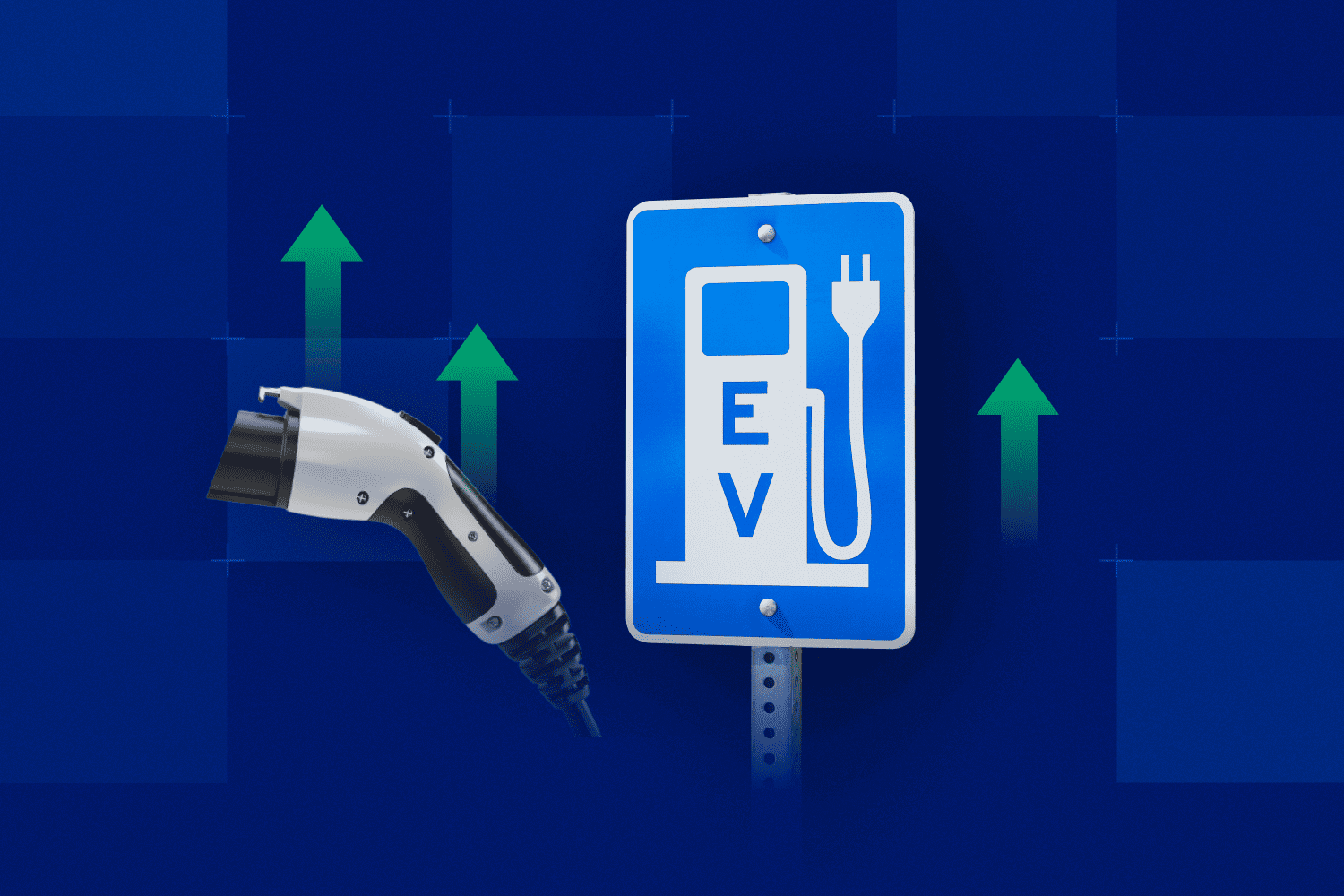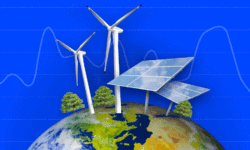A major pillar of the energy transition, electric vehicles (EV) are posed as the key to reducing, and eventually eliminating, the large volumes of carbon dioxide vehicles emit each year.
Transportation is currently the second-largest contributor to carbon emissions, and cars make up a whopping 48% of global transportation CO2 emissions. But with the advent of EVs, there is significant potential to reduce transportation’s carbon footprint and get that much closer to reaching a global net-zero state.
And while gas car sales currently significantly outnumber EV sales, the balance seems to be tipping in favor of EVs with each passing year. In 2023, EVs accounted for 7% of new vehicle sales—a number that is likely to grow as battery technologies improve and EV prices become more affordable.
At the same time, competition in the EV market is heating up, as more and more car manufacturers are investing in the development and launch of their own EVs. This will likely lead to smaller companies being acquired by or merging with larger, more established players.
In 2024, the EV sector is poised for growth, gaining market share both in the U.S. and abroad, though certain headwinds persist. Below, we dive into the top EV trends of 2024, including the charging landscape, emerging players, and much more.
Related Reading: Top 6 Energy Transition Trends to Watch in 2024
The Need for Consumer Education
One of the biggest hurdles to the widespread adoption of electric vehicles has been consumer education or, more so, the lack of it. According to a study by Teads conducted in partnership with Kantar, “only a few brands are already strongly associated with electric vehicles,” and “almost 40% of all respondents aren’t aware of the full benefits of an EV car.”
Electric vehicles are shown to reduce fuel costs dramatically because of the high efficiency of electric-drive components. The US Department of Energy states that “depending on how they are driven, today’s light-duty all-electric vehicles (or PHEVs in electric mode) can exceed 130 MPGe and can drive 100 miles consuming only 25–40 kWh.”
Even still, some skeptics maintain that EVs actually have a larger carbon footprint than non-electric vehicles, due to their manufacturing and battery disposal, as well as reliance on coal to create the electricity that powers them. And while it is technically true that EVs cause more pollution than their gas counterparts during the production process, all of that emission difference is erased as the vehicle is driven. When driving, an EV produces only about 35% of the emissions a gas car does.
The overarching conclusion of numerous studies is that “there are no countries in the world where [battery electric vehicles] pollute more than internal combustion vehicles.” As for the reliance on coal, the long-term plan is to retire coal plants and increase reliance on renewable energy sources, which means an even smaller environmental footprint for EVs.
Some consumers are also hesitant about EVs due to their higher upfront cost, and yet the costs to maintain an electric car, especially battery-powered vehicles, are generally lower than fossil fuel-powered vehicles due to fewer moving parts. EVs have single-speed transmissions and regenerative braking, which mitigates wear on brakes. The best part: EVs don’t require oil changes.
For US automakers, their EV batteries are required to have a warranty for a minimum of eight years or 100,000 miles. However, most EV battery packs have lasted more than 200,000 miles with less than 10% degradation in power capacity, meaning the only regular maintenance costs most consumers incur are new windshield wipers and tires.
Key Global Players and Increased Competition
In 2024, EV sales are expected to be highest in China, followed by Europe, North America, South Korea, and Japan.
Six out of every ten EV sales are from China, where intensifying competition is driving down costs and manufacturer profits. China’s fast-growing electric vehicle market is driving global competition due to Chinese manufacturers like BYD, Chery, and SAIC-GM-Wuling (SGWM) ramping up production and expanding their product lines.
China also has the advantage of over a decade of EV and battery cell development, which allows them to produce their EVs at much lower costs and thus charge much lower prices.
This year, China’s EVs are expected to make up over 25% of the EV sales in Europe. Tariffs will need to be raised to at least 25% to make electric sedans and SUVs imported from China more expensive than their European-made equivalents. Still, European carmakers are not slowing down—at least 15 new EVs are expected to launch in 2024, and EV sales are expected to more than quadruple between now and 2030.
At the same time, Korean car brands Hyundai and Kia are aiming to become EV leaders, particularly in the U.S. Hyundai recently announced plans to invest $51 billion to ramp up electric vehicle development and production in Korea. Meanwhile, the Hyundai Group is opening a $12.6 billion assembly plant in Georgia, as well as two joint venture battery factories with Korean partners.
In 2023, the U.S. had its best year in terms of EV sales. In total, 1.2 million EVs were sold domestically, with Tesla Model Y leading the fray as the best-selling car. And yet, many are pessimistic about the future of the EV market, as automakers like Ford and GM scale back their EV plans and dealers beseech President Biden to slow down on regulations that encourage the shift away from gas cars.
The biggest impediment to consistent sales and new customer acquisition is cost—for now, the cost of production for EVs makes their price far too high for many consumers. But in the next few years, an increasing number of affordable EV models are expected to enter the market, from Chevrolet and Volvo to Tesla.
Developments in Charging Infrastructure
There are a lot of questions facing the global adoption of EVs, but potentially the biggest concern for consumers and manufacturers alike is the challenge of establishing charging networks. China’s impressive adoption rate can be attributed to rolling out charging networks and making charging points readily available, which is the number one obstacle to answering the question consumers pose: where am I going to charge my EV?
A joint announcement was made by automakers Ford, General Motors, Honda, Mercedes, Rivian, and Volvo in 2023, stating that their EVs would be compatible with Tesla’s Supercharger Network from 2024 onwards. This is significant, as Tesla’s Supercharger Network is the largest rapid EV charging station network, with over 45,000 chargers in the U.S.
At the same time, major automakers BMW Group, General Motors, Honda, Hyundai, Kia, Mercedes-Benz Group, and Stellantis NV have announced that they are collaborating to establish a high-powered electric vehicle charging network spanning North America and featuring 30,000 chargers. This charging network is meant to be a Tesla Supercharger alternative and is set to be operational in the U.S. in 2024.
Additionally, gas stations like Shell and BP are utilizing their existing gas station infrastructure to establish EV charging stations globally—a trend that other gas station companies will likely follow to remain competitive in the market.
Navigating the Future of EVs with AlphaSense
Whether you’re researching how your competitors are approaching the energy transition or searching for the next big investment in EVs, you need a market research tool that can help you sort through the noise and uncover opportunities fast.
AlphaSense is a leading provider of market intelligence, including 10,000+ private, public, premium, and proprietary content sources from more than 1,500 leading research providers—all in a single platform. Our external content sources include trade journals, news, and SEC and global filings.
AlphaSense users also have access to the following premium and proprietary content offerings:
- Wall Street Insights® – A collection of broker research from Wall Street’s leading firms, covering global sector themes, industries, and companies from 1,000+ sell-side and independent firms, available within the AlphaSense platform. Research professionals can even preview the contents of a broker report, saving them wasted time and money on potentially fruitless research.
- Expert Insights – 40,000+ transcripts of one-on-one calls with industry experts, competitors, customers, professionals, and former and current executives, with the ability to conduct your own 1:1 expert calls at a 70% cost saving compared to traditional expert network call bundles.
The AlphaSense platform also delivers unmatched AI-search capabilities and features for analyzing qualitative and quantitative research, and can mine unstructured data for the most critical insights, including:
- Automated and customizable alerts for tracking regulatory filings, companies, industries, and potential investments
- Table export tools that support M&A workflows like target lists and due diligence
- Smart Synonyms™ technology that ensures you never miss a source important to your research
- Smart Summaries, our first generative AI feature, summarizes key insights from earnings calls for faster analysis
Sign up for a free trial today to see how AlphaSense can help you get ahead.



